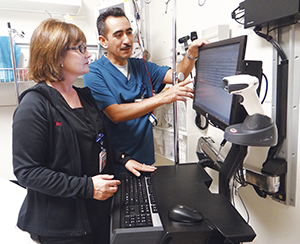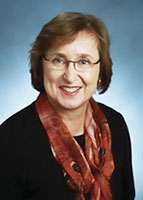A hospital is a high-pressure workplace. Throw in a major new computer program, with its multiple screens and mysterious sequences, and the result can try the most composed veteran nurse.
Enter the Epic Implementation Technicians, or EITs, technology-savvy nursing graduates who can show experienced health professionals when to right click or switch screens while on the job. Providence Health & Services California Region has put the two groups side by side at five of its hospitals to implement a new Epic brand electronic medical records program.

Cesar Alas, a new nurse at Providence Holy Cross Medical Center in Mission Hills, Calif., explains procedures in the hospital’s new electronic medical records program to Terri Halverson, an assistant nurse manager in the hospital’s emergency room.
Most of the EITs are in their 20s, recent graduates of nursing schools and all are thoroughly comfortable with mobile technology. Providence assigned them to work alongside veteran nurses throughout the hospitals when it began using the new system, which eliminates the last of paper records at its hospitals.
Stress buster
Terri Halverson, an assistant nurse manager in the emergency room at Providence Holy Cross Medical Center in Mission Hills, Calif., said the presence of EITs was a calming influence because they were available on the spot to help solve the questions and confusions that routinely dog users of a new computer program.
"I learn these things in a class, but it's much easier to have a person who can walk through the steps right there in the clinical setting," said Halverson, a nurse for 36 years. "It certainly can defuse the stress."
Cesar Alas was one of the EITs who worked in Halverson's ER. At 44, he was the oldest of his fellow EITs, who became known to the veteran nurses as the "tan pants" because of the khaki slacks they wore for identification. Born in El Salvador, Alas didn't have a smartphone in elementary school, as did many of the younger EITs. He learned to use computers while taking college classes to study nursing. Before then he had been a bagger at a supermarket.
Alas said he believed his age and life story gave him an edge of credibility in helping the veteran nurses. "Several told me they thought I understood their situation because I hadn't grown up with a laptop, either," he said.
Training the trainer
Halverson said she was impressed by Alas' enthusiasm, courtesy and honesty. "If he didn't know an answer, he'd tell me that. And then he'd go get the information needed," she said.
Alas said veteran nurses asked such things as when to make a right click on a mouse, how to keep a screen open while moving to another, and how to verify that they had properly entered information. "We took on the role of a nurse, helping them through frustration and showing that everything is okay," he said.
In return, Alas got to see up close how nurses do their jobs. He quickly grew to respect their knowledge of health care and their smooth competence in action.
"I got to see how well they know their jobs, how they can keep their cool and composure and present a sense of confidence that puts patients at ease" Alas said. "It made me realize that developing that confidence is an important part of the job."
Landing the job
Alas now works at Providence Holy Cross Medical Center's telemetry/oncology department in Mission Hills. Katherine Bullard, regional chief nursing officer for Providence Southern California and creator of the EIT project, said it provides a double benefit for the hospitals — the EITs can assist in the on-floor implementation of a new computer program, and nursing supervisors get to see the novice nurses in action.
"We get to see how they perform on a job and learn about their attitudes for the work," Bullard said.

Bullard
Providence hired 180 recent graduates last November to work as EITs. Alas was among the first 50 to be assigned to hospitals in January. Bullard said Providence offered jobs to all of them.
Bullard said she developed the EIT system while working on a doctorate in nursing practice at the University of San Francisco. She said a few other hospitals in California had tried similar methods, but Providence "has the distinct advantage of being able to apply these talents in more than one hospital."
'Super users'
The future EITs spent two months in training on the Epic system.
Bullard said the hospital also sent some of its veteran nurses to the lengthy training program, but was able to limit the number who were away from work because of the EITs. The veterans trained on Epic became known as "super users." When it was almost time to roll out Epic, Providence provided 12 hours of training to the rest of its nursing staff, then sent the EITs onto the floors with the super users to coach and problem solve.
"The assistance has proved highly valuable," Bullard said. "Some veterans know what to do with a new system; others are anxious and uncomfortable. It's always a huge change, and it's usually not an intuitive experience to work with a new data system."
Bullard said she was heartened to see new graduates and experienced nurses offer value to each other, bridging the generational divide.
"Experienced nurses aren't always patient with new graduates," she said. "It was validating to see the young nurses offer their expertise and the veterans look upon them with appreciation."
Copyright © 2014 by the Catholic Health Association
of the United States
For reprint permission, contact Betty Crosby
or call (314) 253-3477.